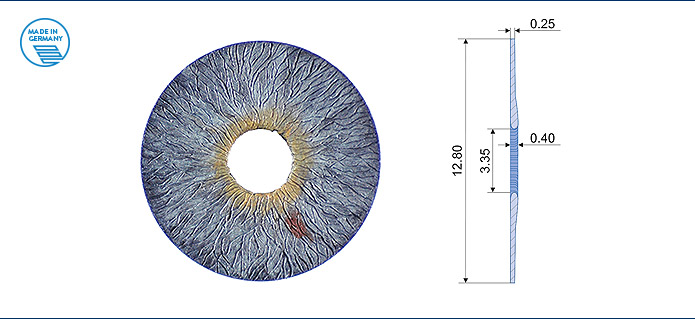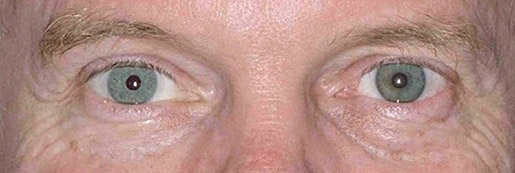
CUSTOMFLEX® – The ARTIFICIALIRIS for patients with aniridia
The CUSTOMFLEX® ARTIFICIALIRIS is the world’s unique and foldable iris prosthesis, for both medical and aesthetic reconstruction of eyes with complete or partial aniridia.
Individually custom-made to mimic the original appearance of the patient´s iris
Injectable
Versatile
Controlled light entry: fixed pupil aperture and opaque material
Biocompatible
For implantation into the sulcus ciliaris or the capsular bag. Combinable with most IOL models.
The artificial iris CUSTOMFLEX® ARTIFICIALIRIS from HumanOptics AG has received FDA approval and currently been approved for medical needs in US.
IMPORTANT :
Not suitable for simply changing the color of the eye;
Suitable for implantation in posterior chamber, not for implantation in the anterior chamber,
Recommended to be implanted after removal of the natural lens and implantation of the IOL.
CUSTOMFLEX®
ARTIFICIALIRIS


ARTIFICIALIRIS – GOOD VISION DESPITE AN IRIS DEFECT!
The natural iris plays an very important role in the optical system and appearance of the eye. Therefore, eyes with aniridia not only have problems with photophobia, glare, and depth of field, but can also affect the quality of life of the patient
Complete or partial aniridia may be congenital, or caused by trauma or illness.
Each case of Aniridia is unique and challenging for the treatment, in which iris reconstruction using a prosthetic implant is an efficient treatment option. HumanOptics (formerly Dr. Schmidt Intraocularlinsen) and Prof. H.-R. Koch (Bonn) has co-developed the ARTIFICIALIRIS, which can be used to treat the condition.
Why ARTIFICIALIRIS?
Correction of ocular problems and aesthetic rehabilitation with the CUSTOMFLEX® ARTIFICIALIRIS results in very high patient satisfaction.

Patient with complete aniridia in the right eye

Same patient after implantation of the ARTIFICIALIRIS
(Pictures courtesy of Kevin M. Miller, MD, Jules Stein Institute, University of California, Los Angeles, USA)

“When I looked in the mirror for the first time after surgery … I cried with happiness. I never expected such a beautiful result.”
Patient statement after implantation of CUSTOMFLEX®ARTIFICIALIRIS. Translated from German.
See for yourself!
Scientific references
What do the experts say?

HANS REINHARD KOCH, MD, HOCHKREUZKLINIK, BONN, GERMANY
“Until recently, aniridia, congenital or acquired, was an untreatable disease. The development of an artificial iris implant has completely changed the situation. With the new device it is now possible to offer an aesthetically perfect and functionally satisfactory solution for all patients
with aniridia or major iris defects. The possibility to do this through a 3 mm incision is an additional benefit.”
Personal statement, 2014.

MICHAEL E. SNYDER, MD, CINCINNATI EYE INSTITUTE, CINCINNATI, USA
“A patient … suffered severe, disfiguring damage to her eye in a car accident as a young child. Now in her 20s, the young woman recently underwent implantation of a HumanOptics artificial iris. She called to tell me that receiving the artificial iris was one of the best things that had ever happened to her …. She still calls or sends a note periodically just to remind me and my team of her happy result.”
Doran M, contributing writer interviewing Miller K, Rosenthal K, Sikder S, Snyder M. Anterior segment iris implants advance – but face continuing challenges. American Academy of Ophthalmology, EyeNet, 2013; Issue February: 29–31.

STEPHAN KAMINSKI, TRIEMLI CITY HOSPITAL, ZURICH, SWITZERLAND
“Until now, iris reconstruction was a challenging surgical procedure requiring large sclerocorneal incisions and often resulting in poor cosmetic outcomes. With the ARTIFICIALIRIS, small self-sealing incisions are possible, enabling fast visual recovery and excellent cosmetic outcomes. The device may be used for complete or partial iris reconstruction.”
Kaminski S. Iatrogenic coloboma, aniridia, and aphakia. J Cataract Refract Surg Today Europe 2012; July/August: 52–54.

IKE AHMED, MD, UNIVERSITY OF TORONTO, ONTARIO, CANADA
“ARTIFICIALIRIS is a device designed to correct the subjective symptoms of aniridia, including photophobia and glare, and to provide an excellent cosmetic result […]. It is a highly versatile tool in anterior segment reconstruction as it can be folded and injected into the capsular bag or sutured to the sclera.”
Gooi P, Teichman J, Ahmed I. Sutureless intrascleral fixation of a custom-tailored iris prosthesis with an intraocular lens. J Cataract Refract Surg 2014; 40:1759–63.
Online Certification Course

ARTIFICIALIRIS: Sulcus implantation - without suture fixation
• Clear cornea_Implantation with injector_Dr.C.Mayer
• Congenital Aniridia-Implantation with forceps _Pr.H.R.Koch, Germany
• CTR application-Implantation with forceps- double sided postop view _ Dr.H.Hashemi, Iran
• Loading the injector and implantation _Dr.M.Snyder, USA
• Pseudophkia-Implantation with forceps _Pr.S.Kaminski, Switzerland
• Scleral tunnel_Implantation with injector _Dr. C. Mayer
• Traumatic Aniridia-Implantation with forceps _Pr.H.R.Koch,Germany
ARTIFICIALIRIS: Sulcus implantation - with suture fixation
• Implantation ArtificialIris and IOL in 2 steps_Dr.C.Mayer
ARTIFICIALIRIS: Sulcus implantation - partial iris with fiber and suture fixation
• Corneal transplant-Conclusion_Dr.J.L.Douenne, France
• Corneal transplant-Part 1 _Dr.J.L.Douenne, France
• Corneal transplant-Part 2_ Dr.J.L.Douenne, France
• Implantation with forcep _Prof.P.Szuman, Germany